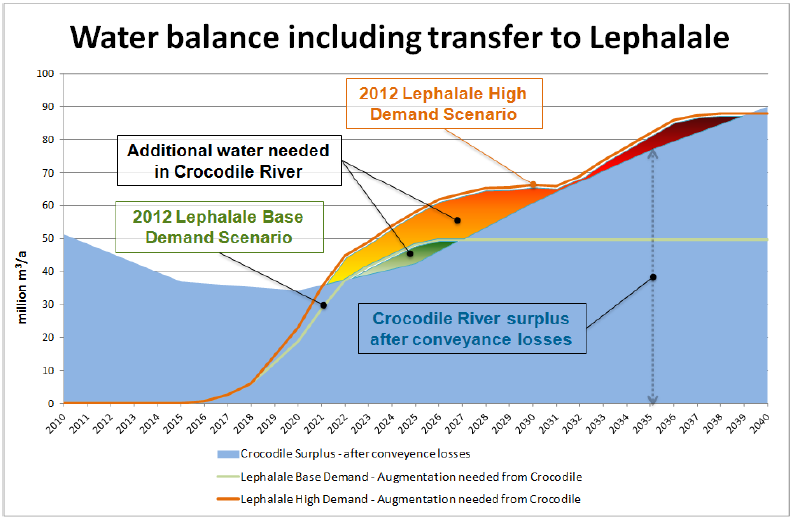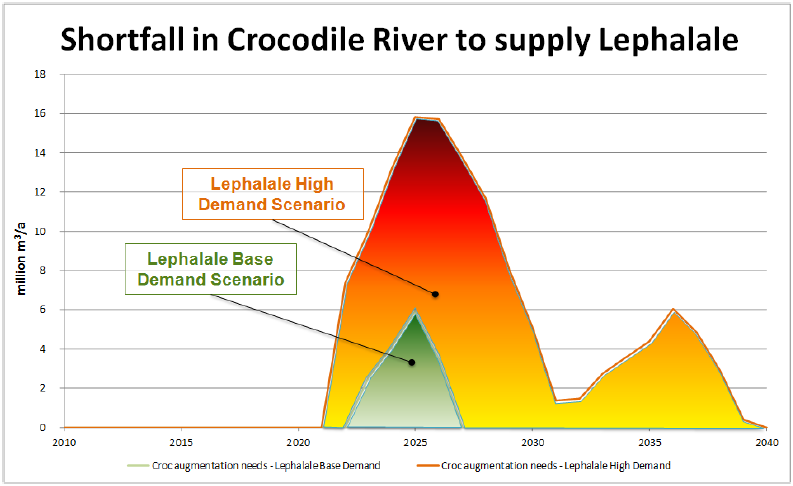Area of Supply
The Crocodile West River Catchment extends northwards from the catchment divide
in Central Johannesburg to the Limpopo River. It is characterised by the
sprawling urban and industrial areas of Northern Johannesburg and Pretoria,
extensive irrigation downstream of Hartbeespoort Dam, and large mining
developments north of the Magaliesberg Mountains.
The Crocodile West River has thus been very heavily influenced by human activity. Noting significant overlap with the Vaal River System, the Crocodile West River
Water Supply System serves a population of about 5.5 million people, with over 20% of
the National Gross Domestic Product (GDP) generated in the Crocodile West River Catchment.
Sources of Water
The water resources that naturally occur in the Crocodile West River Catchment have been
fully developed and utilised. Supplies to Northern Johannesburg, Midrand,
Tshwane (Pretoria) and environs, are transferred in from the Vaal River via the Rand Water Bulk Distribution Network.This represents over 45% of the total water use in the
Crocodile West River Catchment, and results in large volumes of return flow (primarily
effluent discharges) from what was originally water from the Vaal River, being discharged
into the Crocodile West River and its tributaries. This, in turn, constitutes an
important source of water for users downstream in the Crocodile West River.
Planning for the Future
A Water Resources Study entitled “Development of a Reconciliation Strategy for
the Crocodile West Water Supply System” was completed in 2009. The broad
strategy for the management of water resources with respect to the Crocodile West
River System is summarised below:
Water for urban and industrial use in the area south of the Magaliesberg Mountains should continue to be supplied predominantly from the Vaal River System via the Rand Water Bulk Distribution Network. Water for irrigation and rural users should be supplied from local sources. The bulk of the water available in the area north of the Magaliesberg Mountains consists of a combination of local surface resources and return flows. The growth in water requirements in this area will be supplied from the growth in return flows from Northern Gauteng, whilst some rural users should continue to be supplied from groundwater. Large quantities of water need to be transferred to the rapidly developing Lephalale Area to augment the local resources. Water for these transfers can mostly be sourced from the Crocodile West River by utilising the surpluses available from return flows in the Crocodile West River Catchment, but further augmentation from the Vaal River System may also be needed in future.
Water Balance and Reconciliation
The light blue shaded portion of the graph presents the
Water Balance for the entire Crocodile West River Catchment for a Scenario with
High Population Growth and Medium Water Demand Management. This is the balance
after supplying water to all users within the Crocodile West River Catchment.
The growing water requirements in the Lephalale Area in the Mokolo River
Catchment to the north and north-east of the Crocodile West River Catchment exceed
the available water from the Mokolo River System. Studies were
undertaken by the Department of Water and Sanitation (DWS) to investigate possible transfer
of surplus water in the Crocodile West River Catchment to the Lephalale Area by means of the
( Mokolo-Crocodile River (West) Water Augmentation Project ) Phase-2A(MCWAP-2A). All the information pertaining to the Mokolo Crocodile River (West) Water Augmentation Project is available on the DWS Website at the following link: http://www6.dwa.gov.za/MCWAP/
There are currently two sets of water requirements for that area, the 2012
Lephalale Base Demand Scenario and the 2012 Lephalale High Demand Scenario. The
light green and orange lines on the graph below show the net water requirements
for these two scenarios after taking the available yield from the Mokolo River
System into account. It can also be seen that the surplus water in the Crocodile West
River Catchment, if being considered for transfer to the Lephalale Area to meet
the expected shortfall there, is insufficient to supply the total water there.

The green and orange/red areas on the top of the graph above indicate expected
shortages in the Lephalale Area after transferring surplus water in the
Crocodile West River Catchment to Lephalale.These expected shortages are highlighted in
another way in the graph below.
For the Lephalale Base Demand Scenario shortfalls of up to about 6million m3/a
can occur between 2022 and 2025. For the Lephalale High Demand Scenario
shortfalls of up to about 16-million m3/a can occur between 2021 and 2040. The
shortfall is relatively small and temporary. Either infrastructure or demand
side interventions could be considered to achieve a positive water balance.

A Strategy Steering Committee(SSC) comprising key role players and decision-makers,
was constituted in July 2010.This SSC monitors the growth in return
flows, and has regular discussions with developers in the Lephalale Area (Eskom,
Sasol, Mines and others) regarding water requirements, to enable detailed and timeous
adjustments to the Strategy and decisions on further augmentation needs.
The former
BKS (now AECOM) and WRP, supported by Golder Associates and Zitholele, were appointed
to manage and undertake the Crocodile West River System Reconciliation Strategy.The contract period for this assignment was from 28
February 2010 to 27 February 2013.
Reconciliation Strategy of the Crocodile (West) Water Supply System Continuation Phase 2, Crocodile (West) Reconciliation Strategy 2015, was undertaken by AECOM and WRP.This latest Strategy was concludedin 2015, and the Final Report is available on the DWS Website at the followinf link:
|